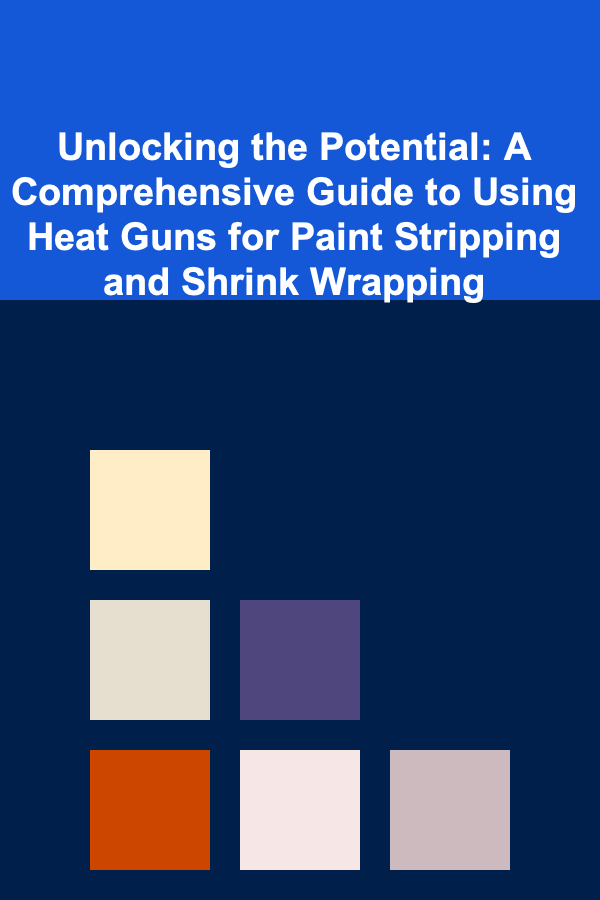
Unlocking the Potential: A Comprehensive Guide to Using Heat Guns for Paint Stripping and Shrink Wrapping
ebook include PDF & Audio bundle (Micro Guide)
$12.99$9.99
Limited Time Offer! Order within the next:

Heat guns, often underestimated in their versatility, are powerful tools capable of performing a wide array of tasks. While they may resemble hair dryers at first glance, their ability to generate significantly higher temperatures makes them indispensable for projects ranging from paint stripping and shrink wrapping to bending plastics and thawing frozen pipes. This comprehensive guide will delve into the intricacies of using heat guns specifically for stripping paint and shrink wrapping, covering safety precautions, techniques, equipment, and best practices to ensure successful and efficient results.
Understanding the Heat Gun: A Tool of Controlled Heat
Before diving into specific applications, it's crucial to understand the fundamental aspects of a heat gun. Unlike open flames or torches, heat guns provide a controlled and directional stream of hot air. This allows for focused heating, minimizing the risk of burning or charring the materials being worked on. The temperature and airflow are often adjustable, providing further control over the heating process.
Key features to consider when choosing a heat gun include:
- Temperature Range: Different models offer varying temperature ranges, typically from around 150°F (66°C) to over 1000°F (538°C). For paint stripping and shrink wrapping, a model with adjustable temperature settings is ideal.
- Airflow Settings: Adjustable airflow allows you to control the intensity of the heat delivered to the surface. Higher airflow is beneficial for covering larger areas quickly, while lower airflow provides more focused heating.
- Nozzle Attachments: Various nozzle attachments can modify the airflow pattern, making them suitable for specific tasks. Examples include:
- Surface Nozzles: Wide, flat nozzles designed for evenly heating large, flat surfaces, ideal for paint stripping on doors and panels.
- Cone Nozzles: Focus the heat into a concentrated area, useful for shrink wrapping around irregular shapes.
- Deflector Nozzles: Shield sensitive areas from direct heat, preventing damage to adjacent surfaces.
- Safety Features: Look for features like thermal overload protection, which automatically shuts off the heat gun if it overheats, preventing damage and potential hazards.
- Ergonomics: Consider the weight and grip of the heat gun. A comfortable grip is essential, especially for extended use. Some models have stands for hands-free operation.
Paint Stripping with a Heat Gun: A Safer and More Effective Method
Paint stripping can be a tedious and messy process. Traditional methods involving chemical strippers often involve harsh chemicals, long waiting times, and potential health risks. A heat gun offers a safer and more efficient alternative, softening the paint for easy removal.
Preparing for Paint Stripping
Proper preparation is essential for a successful paint stripping project:
- Safety First: Wear appropriate safety gear, including:
- Safety Glasses: Protect your eyes from flying paint chips.
- Heat-Resistant Gloves: Protect your hands from the heat.
- Respirator or Dust Mask: Avoid inhaling paint fumes and dust, especially if the paint contains lead. A properly fitted respirator is highly recommended for older homes.
- Workspace Preparation: Work in a well-ventilated area. Cover the surrounding floor with a drop cloth to catch paint chips and debris.
- Surface Preparation: Clean the surface to be stripped, removing any loose paint or dirt with a scraper or brush.
- Choose the Right Nozzle: Select a surface nozzle for large, flat areas or a cone nozzle for intricate details.
The Paint Stripping Process
Follow these steps for effective paint stripping:
- Set the Temperature: Start with a low temperature setting and gradually increase it until the paint softens without scorching. Overheating can damage the underlying surface and create stubborn, hardened paint. Experiment on a small, inconspicuous area to determine the optimal temperature.
- Apply Heat Evenly: Hold the heat gun a few inches away from the surface and move it slowly and steadily across the area you want to strip. Avoid holding the heat gun in one spot for too long, as this can cause the paint to burn or the wood to scorch.
- Scrape Away the Softened Paint: As the paint softens, use a putty knife or scraper to remove it. Work in small sections, scraping the paint away while it's still pliable. Experiment with different scrapers to find the ones that work best for the specific type of paint and surface.
- Repeat as Necessary: Multiple layers of paint may require several passes with the heat gun. Repeat the process until all layers of paint are removed.
- Clean Up: Once all the paint has been removed, clean the surface with a brush or cloth to remove any remaining residue. Sand the surface lightly to smooth out any imperfections.
Tips for Effective Paint Stripping
- Work in Small Sections: Focus on small, manageable areas to prevent the paint from cooling down before you can scrape it off.
- Maintain a Consistent Distance: Keep the heat gun at a consistent distance from the surface to ensure even heating.
- Use a Variety of Scrapers: Different scrapers are better suited for different tasks. Try using a flat scraper for large areas and a detail scraper for intricate corners and edges.
- Be Patient: Paint stripping can be a time-consuming process. Don't rush it, or you may end up damaging the surface.
- Consider Lead Paint: If you suspect the paint contains lead (common in older homes), take extra precautions. Use a HEPA-filtered vacuum to clean up paint chips and debris, and dispose of the waste properly according to local regulations.
Warning: Lead paint is a serious health hazard. If you suspect the paint contains lead, consult with a professional lead abatement contractor before attempting to remove it yourself. Improper handling of lead paint can lead to lead poisoning, especially in children.
Tip: For stubborn areas, try using a chemical stripper in conjunction with the heat gun. Apply the stripper according to the manufacturer's instructions, then use the heat gun to soften the paint before scraping.
Shrink Wrapping with a Heat Gun: Protecting and Securing
Shrink wrapping is a versatile packaging technique used to protect and secure a wide variety of items, from boats and furniture to pallets of goods and individual products. A heat gun is the primary tool used to shrink the plastic film, creating a tight, protective barrier.
Preparing for Shrink Wrapping
Proper preparation ensures a smooth and effective shrink wrapping process:
- Choose the Right Shrink Wrap: Select the appropriate type and thickness of shrink wrap for the item being wrapped. Thicker films are more durable and resistant to tears, while thinner films are more flexible and easier to conform to complex shapes.
- Prepare the Item: Clean the item to be wrapped, removing any dirt or debris. Protect any sensitive areas with padding or cardboard.
- Apply the Shrink Wrap: Drape the shrink wrap over the item, ensuring that it covers the entire surface. Overlap the edges of the wrap by several inches. Secure the edges with tape or shrink wrap staples to hold them in place.
- Ventilation (For certain items): If wrapping items that might be sensitive to moisture or temperature changes, consider adding ventilation. This can be done with special shrink wrap vents.
The Shrink Wrapping Process
Follow these steps to shrink the wrap effectively:
- Set the Temperature: Start with a medium temperature setting and adjust it as needed. The ideal temperature will depend on the type and thickness of the shrink wrap. Too low, and the wrap won't shrink properly. Too high, and the wrap may burn or tear.
- Apply Heat Evenly: Hold the heat gun a few inches away from the shrink wrap and move it slowly and steadily across the surface. Focus on one section at a time, overlapping each pass slightly.
- Observe the Shrink Wrap: As the shrink wrap heats up, it will begin to tighten and conform to the shape of the item. Watch carefully to ensure that the wrap is shrinking evenly and that there are no wrinkles or bubbles.
- Pay Attention to Corners and Edges: Corners and edges can be difficult to shrink wrap properly. Use the heat gun to focus on these areas, carefully shrinking the wrap until it is tight and smooth. Consider using a cone nozzle for more focused heat.
- Seal the Seams: Once the wrap has been shrunk, seal the seams by applying heat to the overlapped edges. This will create a strong, watertight seal.
Tips for Effective Shrink Wrapping
- Start at the Bottom: Begin shrinking the wrap at the bottom of the item and work your way up. This will help to prevent wrinkles and bubbles.
- Overlap Your Passes: Overlap each pass with the heat gun by a few inches to ensure even heating and prevent gaps in the shrink wrap.
- Use a Shrink Wrap Stapler: A shrink wrap stapler can be used to secure the edges of the wrap and hold them in place while you are shrinking it. This is especially helpful for large or complex items.
- Avoid Overheating: Overheating can cause the shrink wrap to burn or tear. Keep the heat gun moving and avoid holding it in one spot for too long.
- Consider a Shrink Wrap Frame: For larger projects like boats, a frame can help support the shrink wrap and make the process easier.
Safety Precautions: Handling Heat Guns with Care
Heat guns, while versatile, are potentially dangerous tools. Following safety precautions is paramount to prevent injuries and accidents.
- Read the Manual: Always read and understand the manufacturer's instructions before using a heat gun.
- Wear Safety Gear: Always wear safety glasses and heat-resistant gloves when using a heat gun. A respirator or dust mask is also recommended, especially when stripping paint.
- Work in a Well-Ventilated Area: Heat guns can produce fumes, especially when used on painted surfaces. Work in a well-ventilated area to avoid inhaling these fumes.
- Keep Away from Flammable Materials: Heat guns produce extremely high temperatures. Keep them away from flammable materials, such as gasoline, propane, and paper.
- Never Leave Unattended: Never leave a heat gun unattended while it is turned on.
- Allow to Cool Down: Allow the heat gun to cool down completely before storing it.
- Inspect the Cord: Regularly inspect the power cord for damage. Do not use the heat gun if the cord is frayed or damaged.
Conclusion: Mastering the Heat Gun for Paint Stripping and Shrink Wrapping
Heat guns are invaluable tools for both paint stripping and shrink wrapping, offering efficient and effective solutions when used correctly. By understanding the tool's features, employing proper techniques, and prioritizing safety, you can unlock its potential and achieve professional-quality results. Whether you're restoring furniture, preparing a boat for winter storage, or packaging goods for shipment, the heat gun is a versatile and reliable asset in your toolkit.

Building Better Games: Innovating in Game Development
Read More
How to Build a Checklist for Conducting Regular Inventory Audits Before Restocking
Read More
How to Deep Clean Your Kitchen in One Day
Read More
How to Make Your Own DIY Home Decor on a Budget
Read More
How to Save Space in Your Garage with Clever Storage Solutions
Read More
How to Interpret Mythological Weapons and Artifacts
Read MoreOther Products

Building Better Games: Innovating in Game Development
Read More
How to Build a Checklist for Conducting Regular Inventory Audits Before Restocking
Read More
How to Deep Clean Your Kitchen in One Day
Read More
How to Make Your Own DIY Home Decor on a Budget
Read More
How to Save Space in Your Garage with Clever Storage Solutions
Read More